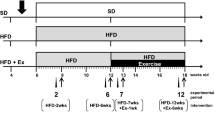Behavioral indicators characterizing specific features of the pathological process of alimentary-dependent diseases were studied using in vivo model of alimentary hyperlipidemia in rats and mice. Rats and mice of the control groups received balanced semisynthetic diet for 63 days; animals of the experimental groups received a diet with high fat content (30% dry weight), balanced or high-fat diet with fructose solution instead of water, balanced cholesterol-enriched diet (0.5% dry weight), or balanced cholesterol-enriched diet with fructose solution. During the experiment, the mass of food, consumed by the animals, was monitored daily. Muscle tone was assessed by the front paw grip strength on days 33 and 54 of the experiment. Anxiety was tested in the elevated plus maze on days 36 and 57. Behavior and memory were assessed by conditioned passive avoidance reflex on days 39, 40, and 61. A significant increase in muscle tone was revealed on day 54 in rats fed with a balanced diet with fructose, and in mice, that received a similar diet, supplemented with fructose and cholesterol. Anxiety in the second test (day 57) was significantly decreased in rats fed high-fat diet and increased in mice fed high fat diet and high fat diet with fructose. In the second test, additional amount of cholesterol in the diet was the factor that significantly improved both short-term and long-term memory in both species. In mice, in contrast to rats, addition of fructose, including combination with high-fat diet, significantly worsened short-term and long-term memory. Thus, dietary factors, contributing to alimentary dyslipidemia development in rats and mice, can significantly affect the indices of neuromotor activity, anxiety level and cognitive functions, and the nature and direction of these changes are largely species-specific.
Similar content being viewed by others
References
Zhuravskii AA, Komissarov IV, Stryuchenko KV, Tikhonov VN. Effect of spermine and glycine on disturbances in conditioned behavior induced by local brain ischemia in rats. Arkh. Klin. Eskp. Med. 2002;11(3):303-306. Russian.
Karkischenko VN, Fokin YuV, Kazakova LKh, Alimkina O.V., Kasinskaya N.V. Methods of studying physiological functions of laboratory animals for preclinical researches in sports medicine. Biomeditsina. 2012;(4):15-21. Russian.
Redkina AV, Loskutova LV, Zamoshchina TA. The GABAА receptors agonists and antagonists influence on formation of a latent inhibition at rats with different levels of anxiety. Bull. Sib. Med. 2012;11(1):66-70. Russian.
Sashkov VA, Sel’verova NB, Morenkov ED, Ermakova IV. Levels of neuroactive steroids in the brain and gender-related characteristics of the formation and extinction of a conditioned reflex in rats. Neurosci. Behav. Physi. 2013;43(8):957-962.
Folomkina AA, Orlova NV, Bazyan AS. Influence of acute melipramine administration on locomotor activity and defensive conditioned reflexes of passive and active avoidance in rats. Zh. Vyssh. Nervn. Deyat. 2004;54(6):829-834. Russian.
Guide for the care and use of laboratory animals, eighth edition. Committee for the Update of the Guide for the Care and Use of Laboratory Animals; Institute for Laboratory Animal Research (ILAR); Division on Earth and Life Studies (DELS); National Research Council of the National Academies. Washington, 2011.
Hutcheson R, Rocic P. The Metabolic syndrome, oxidative stress, environment, and cardiovascular disease: the great exploration. Exp. Diabetes Res. 2012;2012. ID 271028. doi: 10.1155/2012/271028.
Metz GA, Schwab ME, Welzl H. The effects of acute and chronic stress on motor and sensory performance in male Lewis rats. Physiol. Behav. 2001;72(1-2):29-35.
Nagayach A, Patro N, Patro I. Experimentalli induced diabetes causes glial activation, glutamate toxicity and cellular damage leading to changes in motor function. Front. Cell. Neurosci. 2014;8:355. doi: 10.3389/fncel.2014.00355.
Peled-Kamar M, Lotem J, Wirguin I, Weiner L, Hermalin A, Groner Y. Oxidative stress mediates impairment of muscle function in transgenic mice with elevated level of wild-type Cu-Zn superoxide dismutase. Proc. Natl Acad. Sci. USA. 1997;94(4):3883-3887.
Reeves PG, Nielsen FH, Fahey GC Jr. AIN-93 purified diets for laboratory rodents: final report of the American Institute of Nutrition ad hoc writing committee on the reformulation of the AIN-76A rodent diet. J. Nutr.- 1993;123(11):1939-1951.
Author information
Authors and Affiliations
Corresponding author
Additional information
Translated from Byulleten’ Eksperimental’noi Biologii i Meditsiny, Vol. 163, No. 1, pp. 46-51, January, 2017
Rights and permissions
About this article
Cite this article
Apryatin, S.A., Sidorova, Y.S., Shipelin, V.A. et al. Neuromotor Activity, Anxiety and Cognitive Function in the In Vivo Model of Alimentary Hyperlipidemia and Obesity. Bull Exp Biol Med 163, 37–41 (2017). https://doi.org/10.1007/s10517-017-3732-z
Received:
Published:
Issue Date:
DOI: https://doi.org/10.1007/s10517-017-3732-z




